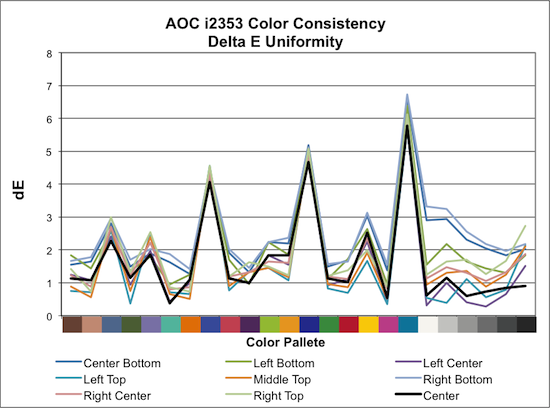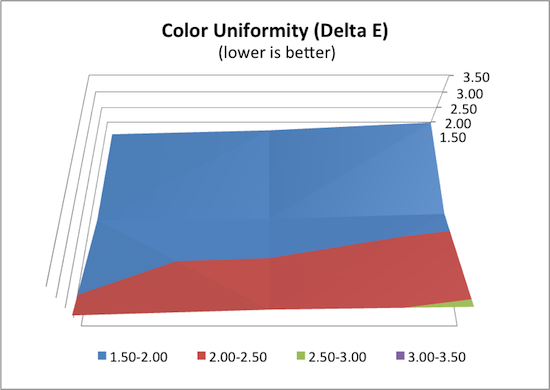AOC i2353Ph - IPS for a nice, low price
by Chris Heinonen on January 30, 2012 12:40 AM ESTUniformity and Contrast
The dE numbers for the AOC have looked good so far, but all of those are for the center of the screen, where backlighting should be the most even and the image should be at its best. To make sure the monitor will give a good overall experience, we also take a set of 9 measurements across the screen using the Gretag Macbeth color chart and see how it does.



The color uniformity across the monitor is surprisingly very good, with very little deviation across any of the colors. The grayscale doesn’t perform quite as well, with the center having an average dE below 1, but a couple other measurements hovering in the range of 2-3 dE. Even the two worst locations still maintained an average dE of 2.55 or less, and the majority of all the results were below 2.0 dE. Overall it has very uniform color across the display.
Since LCD panels are all lit by their backlight to provide color, any errors across the screen can often be traced back to a backlighting system that is uneven and causing those color shifts. As we look at the brightness level across the display when the center is set for 200 nits, we see the drop-off at the bottom of the screen. If the LCD panel itself is behaving the same no matter the location on the screen, the different amounts of light can easily cause the shifts in color that we saw in the last test. Here the locations that had the worst dE uniformity also have the worst brightness uniformity, which is likely the root of the problem.

Once we have found the issues with the brightness, we check to see how well the backlighting system handles darkness across the display. With the AOC there seems to be significant light leakage in the corners of the display, with black levels that are very, very high for the display. I’ve recently seen LED backlit models with good control of the backlight that can get down to very low black levels, but the black levels in the AOC remain high. Some of this is due to the IPS panel, which typically has higher black levels than other panel types. It also could be an area where corners had to be cut to make the aggressive price point that AOC targeted. Regardless of why, the absolute black level is not going to please people that are adamant about deep, dark blacks.











71 Comments
View All Comments
cheinonen - Monday, January 30, 2012 - link
There are 120Hz TN displays available now, and we recently reviewed one from Samsung which you can find. With gaming, I found the 120Hz refresh to be really nice and make a noticeable difference in how smooth the image was compared to 60Hz. There are no IPS panels available that do 120Hz that I know of, but since you can get 120Hz HDTVs that use IPS panels (they don't accept 120Hz signals, but can display 720p60 frame packed, which is basically 120Hz by a different name) I'd hope that desktop displays using this aren't far away.Do people think that 1 frame of lag is the acceptable cut-off point then? Since there are displays that can do 10ms or less, I tend to think that we should aim for > 0.5 frames of lag as an ideal, but that's also harder to find. I play some games, but I'm not good at FPS games anymore, so my saying that I found 1 frame of lag acceptable is much different than someone who is actually good finding that acceptable.
vailr - Monday, January 30, 2012 - link
What about OLED monitors? I heard that OLED TV's were seen at CES in Las Vegas a few weeks ago, but nothing mentioned about OLED PC monitors.jesh462 - Monday, January 30, 2012 - link
If you get a higher quality panel (Dell/NEC) display port lets you reach over 80hz refresh rates with some tweaks. It's not 120hz. It's also not a dirty TN panel.As for OLED, I believe it's a lost cause for desktop/laptop monitors. Manufacturers are already switching to Quantom Dot technology for production *this year*.
annnonymouscoward - Monday, January 30, 2012 - link
> Do people think that 1 frame of lag is the acceptable cut-off point then?I'm extremely sensitive to lag--so much that I'm turned off from every Droid phone I've ever used. And I've owned a 3007WFP-HC for years, which averages 11.5ms of lag according to digitalversus. I've never perceived lag on it, and I play FPS. I'd never buy a monitor with 30ms lag. The general public can't notice 50ms lag.
I find 60Hz to be the huge limiting factor in FPS's, since getting an update every 16.7ms isn't enough information when trying to target on the fly.
I think there's a sizable market for premium new displays, if some company would have the sense to make them. Instead, all we get is crap. They take monitor tech we've had for 6 years, reduce 3", make it 16:9, and maybe even glossy. There has been virtually zero improvement to the 30" IPS models that came out 6 years ago. I want a 36", X-IPS, WUVDIQXGA, with a polarizer filer, 80Hz minimum. No more 16:9 60Hz garbage.
jaydee - Monday, January 30, 2012 - link
If they could have squeezed in a DisplayPort and 1920x1200 res for just 20-30 more, this would be a great deal IMO. It's a good deal as it is, I was hoping for just a little bit more.CZroe - Monday, January 30, 2012 - link
Shouldn't the freakin' size be in the title, synopsis, or the first paragraph of the article?!TerdFerguson - Monday, January 30, 2012 - link
Great review. Thanks for the info.jleach1 - Tuesday, January 31, 2012 - link
I've been ogling IPS displays for years, but always walked away with one thing in mind...sticker shock!Can you Anandtech staff and the readers recommend an IPS display for the budget-conscious? I understand they're going to be more expensive than their run-of-the-mill partners, but I'm speaking in relative terms.
It wouldn't be for professional use, but rather gaming and video goodness!
Preferably something between 23-25 inches.
Thanks!
J
sviola - Tuesday, January 31, 2012 - link
Hey Chris,Can you guys get in touch with LG and do a review of their new 120Hz IPS monitors due to market this February. The series are the DM92 (27") and the DM82 (23").
Many Thanks
cheinonen - Wednesday, February 1, 2012 - link
These aren't 120 Hz IPS displays. They use circular polarization, much like the Viewsonic monitor we recently reviewed, so each eye gets a 1920x540 image when running at 60Hz. If they were 120Hz we would certainly be interested, but it looks to be a passive 3D display, albeit with IPS instead of TN.